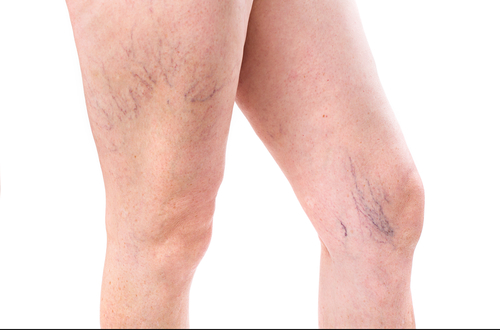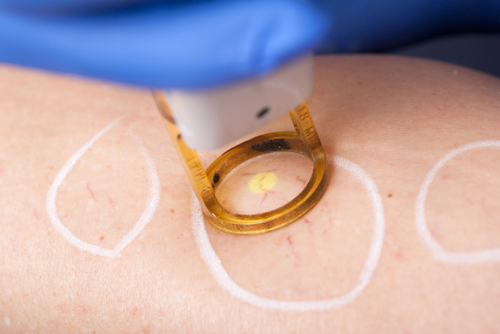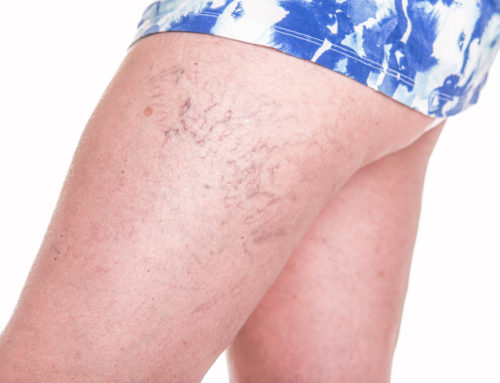According to the VSGBI, there are approximately 60,000 miles of blood vessels in the human body. These blood vessels are responsible for transporting blood throughout the body, oxygenating it, and delivering it to the right places. That’s why it’s so important to keep an eye on these tiny little blood vessels and make sure they are in tip-top shape.
Today we’re going to take a look at veins – the blood vessels responsible for transporting blood to the heart. Specifically, we’re going to talk about a very common condition called spider veins.
First off, please keep in mind that this condition is incredibly common, affecting millions of women in the US alone. So don’t panic quite yet if you notice a few spider veins on your legs. Simply consult with your primary care physician after reading our article.
What Are Spider Veins?
Spider veins are very thin, damaged veins that can typically be seen just under the surface of the skin. These veins will usually look like purple, red, or blue thread-like structures. They may also fan out in a web-like appearance.
Fortunately, although spider veins may look a little scary when you first notice them, they cause little to no physical harm. Generally speaking, spider veins are considered more of a cosmetic nuisance.
Spider veins can also appear in various of locations across the body, which is why you might notice them on your legs, face, ankles, or other areas of the body.
Fortunately, there are a number of treatment options that can help reduce the appearance of these veins and alleviate minor symptoms.
Let’s start with the basics.
What Causes Spider Veins?

The general cause of a spider vein is damage to the structure of the vein. The exact way the damage happens does vary, depending on the location and type of vein.
Here is a breakdown of what causes spider veins in each area:
Spider Veins On Legs
Spider veins in the legs occur when one of the valves in a vein malfunctions. When there’s no functioning valve to push blood in the right direction, it pools, straining against the walls of the vein, creating those purple spider veins that we see.
Spider Veins On Ankles
Similar valve malfunctions cause spider veins around the ankle area as those found in the legs. Having said that, spider veins found specifically in the ankle area can sometimes imply an underlying health condition. So if you do notice small purplish veins in your ankles, make sure to let your doctor know.
Spider Veins On Face
Spider veins in the facial area are caused by broken blood vessels. Unlike in other parts of the body, these can be caused by a variety of things, including heavy blood pressure (drinking, yelling, sneezing, etc.), aging, damaged skin, and even some dermatological conditions.
General Risk Factors
There are also a handful of general risk factors that increase your chances of developing spider veins. These are:
- Gender (women are more likely to develop spider veins).
- Genetics (if your family has a history of spider/varicose veins, you’re more likely to develop them).
- Obesity
- Pregnancy
- Being older
How To Prevent Spider Veins
Since two of the heaviest contributors to spider vein development are genetics and gender, it’s impossible to prevent these types of veins from occurring completely. But, there are a few things you can do to reduce your chances of developing spider veins.
These are:
- Maintaining a healthy weight.
- Exercising regularly (preferably without putting a lot of weight on your legs for very long periods of time).
- Elevating the legs.
- Using compression stockings/socks.
How To Get Rid Of Spider Veins

There are a few ways to reduce the appearance and symptoms of spider veins at home. These include things like wearing compression stockings, exercising in moderation, and elevating your feet.
Completely getting rid of spider veins is only possible with medical intervention. Fortunately, most of these procedures are minimally invasive, and recovery is swift.
Spider Vein Treatment
Here are a few common surgical treatments:
- Sclerotherapy – One of the most popular treatment options for spider vein removal. This is a very straightforward procedure during which your doctor injects a sclerosant solution into your spider veins. The solution irritates the vein, forcing it to close up. The blood will then be rerouted to other healthy veins.
- Radio Frequency Ablation – This is a treatment that uses radio energy to generate heat, causing the vein to seal up and be reabsorbed into the body.
- Laser Treatment – Uses laser heat to damage the vein, causing it to close up and be reabsorbed back into the body.
Please keep in mind that there is no way to get rid of spider veins using only home remedies. Stay wary of online resources that claim to have a home remedy to cure spider veins instantly.
Are Spider Veins Dangerous?
The short answer is typically not. Most often, spider veins are simply a cosmetic issue and cause little physical harm. Some patients may feel a slight heaviness or discomfort in their legs due to spider veins, but this can be treated with over-the-counter pain medication.
Very rarely, however, a complication related to the veins may occur. Possible complications include blood clots, ulcers, and bleeding. If you experience any of these complications, the best thing to do is to consult with a medical provider as soon as possible.
Additionally, please keep in mind that not all discolored veins are spider veins. Don’t hesitate to reach out to a medical provider if you notice anything concerning.
Does Insurance Cover Spider Vein Treatment?
The short answer is…typically not. To be more specific, however, insurance plans usually do not consider cosmetic procedures necessary, and therefore choose not to cover them. Occasionally it is possible to get a vein-related procedure at least partially covered. If your spider veins lead to some kind of health complication or have an otherwise serious impact on your life, your insurance plan may cover some of the costs associated with the procedure. The best thing to do is to reach out to your insurance company to verify your plan’s policy. Getting a recommendation from your primary care physician or a vein specialist may be helpful as well.
VeinSolutions™ at Michigan Vascular Center
Do you still have questions regarding a vein concern? Don’t hesitate to reach out! We’re more than happy to meet new patients.
Our VeinSolutions™ center is a specialty solution created for patients with therapeutic and cosmetic vein problems. Open since 2003, this center has been servicing the Michigan community for over a decade. Our medical providers aim to provide the best quality of medical treatment in the area. We serve patients all over Michigan, so whether you live in Flint, Ann Arbor, or Lapeer we’re the vein experts for you.
VeinSolutions™ provides treatment for varicose vein concerns such as spider veins, varicose veins, ulcers, discoloration, and much more. Not only this, but our center provides FREE vein screenings. We want you to feel as prepared as possible before embarking on your vein treatment.
Book a consultation, and one of our physicians will perform a FREE screening, evaluate all of your symptoms, recommend further testing if needed, and develop a treatment plan for you. Not only this, but we’ll provide you with a cost estimate so that you can walk into your next appointment with no surprises on the other end of it.
Simply give us a call at (810) 232-3363 or send us an email to schedule an appointment.
Request A Consultation
Give Us A Call:
(810) 232-3363
Give Us A Call:
(810) 232-3363



